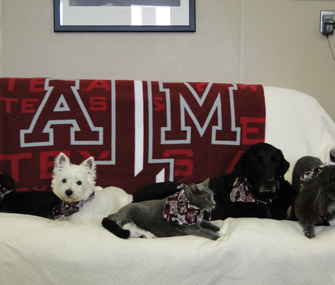Trend Watch: Retirement Homes for Pets
Published on June 28, 2012

On any given day at the Stevenson retirement home, residents may be hanging out in the living room, ambling through the kitchen in search of a snack, exercising in the yard or getting a medical checkup.
But these residents aren’t people — they’re cats and dogs.
The Stevenson Companion Animal Life-Care Center, based at Texas A&M University’s veterinary school, is just one example of a new trend in companion animal care — pet retirement homes.
These centers provide perpetual care for pets who either outlive their owners or whose elderly keepers are no longer able to tend to them.
Unlike shelters that try to get animals adopted, these sanctuaries offer both a communal home and medical care for the rest of the pets’ lives.
Why There's Such Demand Now
Susan Hamil, the chairman of the board of directors for the Blue Bell Foundation for Cats, a feline retirement facility in Laguna Beach, Calif., believes that deepening affection for pets prompts better planning for end-of-life care.
“Pets are considered members of the family more than they ever were before,” she says. “The question of ‘what would happen if something happened to me?’ now extends to ‘what would happen to my cat?’ ”
For instance, a pet owner may need to move into an assisted living facility that doesn't accept animals. Or the owner may not have family or friends who could take in the pet.
And that’s where a pet retirement home comes in.
Owners pay an enrollment fee to guarantee their pets’ placement and then usually set up an endowment to cover future costs. And many centers report a rising number of registered pets.
Sharon Worrell of the Cohn Family Shelter at Oklahoma State University’s veterinary school points to the baby boomer generation for this trend. As these pet owners age, and their companion animals enjoy longer life spans, they become more concerned about their pets’ future care, as well as their own.

What You Can Expect From a Pet Retirement Center
Pet retirement sanctuaries aim for a homelike environment, complete with lounges, sleeping rooms, exercise yards and sunrooms or patios. (We all know how pets love sunbeams!)
Some homes are species-specific, sheltering only cats or dogs. Others are “coed,” opening their doors to cats, dogs, birds and even — as is the case at Stevenson — a llama. There’s room for people, too, so staff can stay on hand 24 hours a day.
Pets are groomed regularly, and they receive medical and dental checkups, usually in the center’s own treatment rooms. If a pet has a health issue, such as diabetes or hypertension, the staff will monitor treatments and medication.
When pets arrive at their center, they should bring their usual food and water dishes, favorite toys and other familiar, comforting things to “help them understand that this is now their new home and to give them a feeling of security,” explains Stevenson's Ellie Greenbaum.
Of course, acclimating is a slow but steady process.
At Blue Bell, for instance, cats start out in private suites, since felines tend to be territorial. “When the cat’s comfortable, we’ll open the door, and they come out in the general area, where a staffer can watch them,” Hamil says. “It can take two to three weeks or six months. It really depends on the cat and its personality.”
Depending on the center’s setup, animals may be able to freely roam most of the house, as well as join group play sessions. Pets can also receive visits from friends and family.
Most important, Worrell notes, “pet owners can feel secure in the knowledge that their pets will receive the love, care and attention they enjoyed at home.”
5 Questions to Ask When You're Researching a Facility
Hamil suggests inquiring about these five points when you’re looking for a pet retirement home to ensure that the center “won’t run out of money, space or emotion.”
1. Safety Is the facility licensed with animal control? When was the last inspection, and how was its evaluation?
2. Layout How many animals are currently living there, and how big is the facility? Consider this information, along with the number of employees. Does it seem like a comfortable environment? Are there enough staffers to spend time with each pet? Or does it look — and sound — overcrowded?
3. Finances Will the organization share its tax returns and other financial records? You need to make sure that the facility has solid financial footing, so that it doesn’t run out of funds.
4. Medical Staff Does the center have a dedicated veterinarian? How long has it worked with the vet? The facility should have a close and steady relationship with a particular veterinary group, so that the pets get a consistent standard of care.
5. Emergencies What is the shelter’s emergency evacuation plan, and is it registered with local authorities? Should the pets need to be evacuated because of a fire or a natural disaster, the staff and local responders should have a plan in place.





